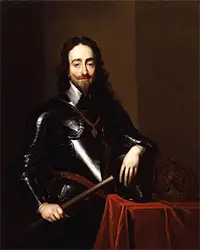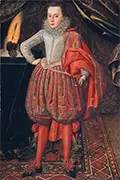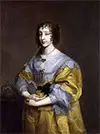King Charles I of England
Part 1: Early Reign Charles I was King of England for nearly a quarter of a century in the 17th Century. He is known first and foremost for losing his He was born on Nov. 19, 1600, in Fife, Scotland, the second son of the eventual King James I. His father was King James VI of Scotland at the time; he became King James I of England in 1603. Charles was a weak and sickly infant and young child. Slow to speak, he also developed a stammer that he never lost. James's oldest son was Henry. He died in 1612, and Charles became Prince of Wales. Charles and Henry were friendly toward each other. When Henry died, Charles looked to his father's best friend, George Villiers, Duke of Buckingham, for advice and friendship. Among the things that Buckingham did for young Charles was to take him on a tour of Spain. The idea was to find a Spanish princess for Charles to marry. King Philip III of Spain had other ideas for suitors for his daughters (as did the English Parliament, who were still hostile toward Spain in the wake of the attempted invasion of the Spanish Armada by Philip's father) in 1588, and Charles and Buckingham went on to France, where Charles met the girl that he would eventually marry, Princess Henrietta Maria, the daughter of France's King Henry IV. The marriage took place in 1625, three months after Charles became king. He was crowned on March 27 and married on May 1. They had five children, two of whom ruled England: Their son Charles became King Charles II in 1660, and their daughter Mary became Queen Mary II in 1688. 
Henrietta Maria was a Catholic, and this alienated many people in England who had embraced the Church of England variant of Protestantism (as Since 1618, Europe had been on fire with the Thirty Years War, which pitted Catholic countries against Protestant countries. The thought that the King of England would marry a Catholic woman angered many people in England. Queen Mary I had married a fellow Catholic monarch, Spain's King Philip II, and Protestant people then had feared a Catholic dynasty on the throne. Mary's successors, Elizabeth I and James I, had stopped that from happening. Charles had a personal interest in this war because his sister Elizabeth was the Queen of Bohemia and the husband of Frederick V, the Elector of the Palatinate, sworn enemies of the Catholic Holy Roman Emperor. Next page > Storm Clouds Building > Page 1, 2, 3 |
|
Social Studies for Kids
copyright 2002–2024
David White



 kingdom and his head in a struggle with Parliament.
kingdom and his head in a struggle with Parliament. begun by
begun by 
